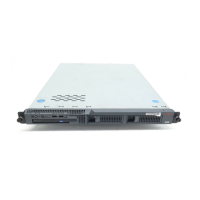Replacing the SAMP on the Avaya S8500C server
03-300529 Issue 4 January 2008 109
S8500C network interface card connections
The optional dual network interface card (NIC) is used in a configuration where the customer
chooses to implement the control network between the S8500C server and the IPSIs as a
private, dedicated network. In other words, the control network is not combined with the
“Corporate LAN” on the same Ethernet port. This provides a more robust control network in
terms of reliability and security, since control network traffic is the only traffic riding this network.
Eth 1 on the SAMP is not used.
Note:
Note: If an optional dual NIC is not present, the Enterprise LAN is combined with CNA
on Eth0 and the Web selections for Eth 2 and Eth 3 are not available.
All ports are located on the rear of the server. See Table 1
.
See (Figure 25: S8500C server, rear view
on page 107) for the Ethernet port locations on the
dual NIC. For information about Ethernet port assignments see Ethernet interface mapping
on
page 155.
S8500C modem connections
There is one modem on an Avaya S8500C server configuration that connects to the USB port
on the SAMP (see Figure 27: Modem connections on the Avaya S8500C server
on page 110).
Required options on the SAMP modem are set by Avaya defaults on the SAMP.
Table 1: Network Interface Card Ethernet designations
Web Designation Use Mother Board Dual NIC
Eth 0 (LAN 1) CNA Eth 1
Eth 1 (LAN 2) Services laptop Eth 2
Eth 2 (LAN 3) Customer LAN Eth 1
Eth 3 (LAN 4) Not used Eth 2

